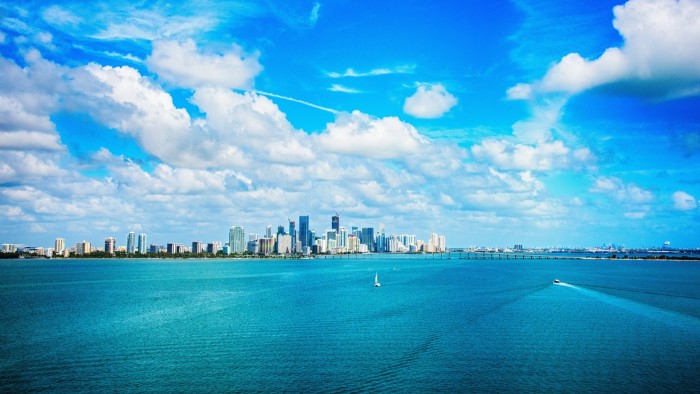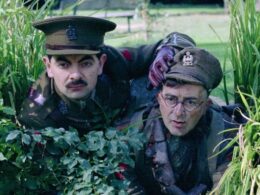This article is part of FT Globetrotter’s guide to Miami
It’s pretty difficult to drive around Miami without hitting the water. Trust me, I know. Like that time during university when I missed a turn and almost drove into a canal (it appeared out of nowhere). And when I tripped while chasing my friend’s runaway dog on South Pointe Pier in Miami Beach, and nearly toppled over the railing into the Atlantic.
Still, I would take these risks any day, because Miami has given my friends and me the rare chance to live an exciting urban life with easy-to-access waterside escapes. This complex metropolis is hugged by the Atlantic and cleaved by natural rivers teeming with manatees and mangroves. If you add up the rivers, coastline and canals, my city has a whopping 470 miles of waterways — roughly the distance from New York to Cleveland or London to Dundee.
Miami’s siren song, in turn, calls us to the water all the time. Unlike other cosmopolitan coastal American cities, like New York or San Francisco, it has such easy access to safe, swimmable water that you can dip into the ocean on your lunch break.
After a lifetime of research, I have compiled some of the best ways to enjoy Miami’s water — from paddle-boarding to boating to fishing to straight up swimming. Just remember: the sun is hot here, so bring a hat and sunscreen is your friend.
For kayaking and paddle-boarding
Oleta River State Park
When my friends and I feel like extracting ourselves from Miami’s glitzy veneer, we often head to Oleta River State Park. An easy 30-minute cab ride north of downtown Miami, it feels light years away from the city’s shinier surface. Here, you can walk past visitors barbecuing on the park’s many grills and encounter a taste of Old Florida: an untouched landscape full of wildlife, from soaring egrets and herons to meandering turtles.
It may surprise you that a place like Oleta exists in Miami: it is Florida’s largest urban park, a natural oasis of about 1,000 acres that is sandwiched between the bustling city corridors of Collins Avenue and Biscayne Boulevard.


Oleta River State Park is one of my favourite places to launch my paddle-board. Gear rental is a breeze through Oleta River Outdoor Center (open from 9am on weekdays, and 8am on the weekends), where kayaks are $25 an hour and stand-up paddle-boards are $30. The waterways here are meant for both novice and experienced paddlers and kayakers, but if you’re not great at steering, avoid the narrower parts. You may end up, as I have, trying to dislodge a kayak out of the native mangrove roots.
If you’re hungry, there’s a great casual restaurant with reggae vibes called the Blue Marlin Fish House on the north-west side of the park. It’s historic, too, open since 1938 — originally as a smokehouse and trading post for local fishermen.
-
Good for: Autumn respites. Early fall mornings bring cooler weather, and within a few hours, it warms up, making a dip in the waters the perfect cool-down after a good paddle-board workout
-
Not so good for: Insect phobias. The flies can get gnarly during the summer, so bring repellent
-
FYI: Park hours are 8am to sundown every day, but come early, because it frequently closes if it reaches capacity. Also, there are no lockers for personal items, so leave your valuables at home or take a waterproof bag
For sailing and boating
Biscayne Bay
Biscayne Bay hosts that postcard-perfect image of Miami — you know, the ubiquitous one posted by influencers, with skyscrapers in the background and aquamarine waters in front. The bay is a lagoon full of living species, from wild fish to wild partiers, and its views have helped solidify the city’s identity in many Hollywood films, including 2 Fast 2 Furious and Scarface.

Biscayne Bay is Miami’s version of the Hudson river in New York — if the Hudson was a tropical bay with glistening, unimaginably blue seas. The northern tip runs alongside downtown Miami, past its massive skyscrapers, and then it extends southward some 40 miles to the nearby city of Homestead. Within it is paradise: 221 square miles of water, which includes Biscayne National Park (see below) and its tiny charming islands, verdant with gumbo limbo and mangrove trees.


There are a few ways to get on a boat in Biscayne Bay. You can buy tickets for a 90-minute boat tour with Miami On The Water on a double-decker vessel ($35 for adults, $26 for children). For a more premium option, you can charter a private boat with Miami Yacht Charter on any vessel from its fleet, which includes mega yachts and catamarans.
-
Good for: Taking that Instagram post that will make your friends jealous
-
Not so good for: Solitude. If you want to avoid crowds, come on a weekday
-
FYI: Reserve your boat plans ahead of time — things fill up
For swimming
Bill Baggs Cape Florida State Park
Indeed, one of the most basic yet pleasurable things we can do in Miami’s waters is swim in it. The best place to do that at is the beach at Bill Baggs Cape Florida State Park, where the soft sand beckons you to plop down a towel and jump in. The waters are turquoise and extremely calm, thanks to nearby reefs that buffer the waves.
The park has a storied history: it is named after an influential Miami newspaper editor who championed civil rights and ecological preservation, and was a critical site on the Underground Railroad for runaway slaves to disembark to the Bahamas. At the southern tip of the beach, a 95-foot tall lighthouse built in 1825 proudly stands; if you have the stamina, you can climb up it. (There are tours of the lighthouse from Thursday to Monday at 10am and noon.)


The beach is located at the south of Key Biscayne, a five-mile long barrier island that is connected to the rest of Miami by a long causeway over the bay. You can take a taxi, but I’d recommend renting a car so you can spend the day exploring. On the way to the beach, stop for takeout at Mestizo Latin Cuisine & Coffee for an easy Miami-style picnic. I like their arepas and empanadas.
-
Good for: Calm, beautiful waters and really friendly locals
-
Not so good for: Partying — it’s remote and low-key. It is, however, great for hangovers
-
FYI: Entrance fee is $8 per vehicle. Rental chairs are available for $15 and beach umbrellas for $25 at the park’s concession stand
For snorkelling
Biscayne National Park
Covering part of the third-longest coral reef system in the world, Biscayne National Park is home to more than 600 native species of fish. That’s pretty incredible, for a national park so close to Miami’s bustling downtown.
On the southern end of Biscayne Bay, the park is one of Miami’s crown jewels. It is almost completely submerged (95 per cent of the 173,000-acre park is underwater) and is now the final resting place of dozens of wrecked ships that never made it to Florida’s shores. Bad for them, but great for curious snorkellers.

To get beyond the visitor centre you have to take a boat, so pre-book a full- or half-day guided tour (from $115) with the Biscayne National Park Institute and drive to its departure point in nearby Homestead (about 35 miles from central Miami). The always-clear waters are pretty shallow, making it a manageable enough spot for beginner snorkellers. And if you prefer to scuba dive, they do that, too — a knowledgeable Institute naturalist can take you on an underwater adventure.
-
Good for: Beginner snorkellers and families, if everyone is an above-average swimmer
-
Not so good for: A quick trip — this takes a day. Reserve a guided experience ahead of time
-
FYI: Pack lunch, snacks and a water bottle. No food service is available at the park or on the Biscayne National Park Institute boats
For fishing
Haulover Inlet and Beach Park
Haulover Inlet in northern Miami is teeming with blackfish tuna, sailfish, mutton snapper and black grouper, making it a jackpot for those who love the thrill of the hunt. A few years ago, a group of anglers even caught a 400lb swordfish.
Fish is not the only thing this area is packed with. A man-made channel between Sunny Isles and Miami Beach, Haulover bridges the northern end of Biscayne Bay with the Atlantic Ocean, making it a dynamic spot where many things converge: jet skiers who like the unpredictable waves, sunbathers lounging on the white-sand beach (one part is famously clothing-optional) and kite flyers along the shore. Tuesday nights bring a lively crowd, thanks to Haulover’s Food Truck Tuesdays from 5pm to 10pm. The area near Bill Bird Marina is lined with vendors, and the energy pumps with a live DJ set.


Before you start fishing, make sure you have a valid fishing licence, which is easy to get at GoOutDoorsFlorida.com, and book a rod-and-reel combo with Reel Play Fishing Rentals, who will hand-deliver the gear to you (24-hour notice required). Then take a short Lyft ride to Haulover, where you can buy bait at the Haulover Marine Center. After that, cast away.
-
Good for: Experienced anglers love it here — they enjoy the challenge of the unpredictable waters
-
Not so good for: Relaxing conversations. The crowd and onlookers tend to get pumped up when a big catch is hauled in
-
FYI: The sun is extra-hot here. Bring sunscreen, sunglasses, a hat and UPF-rated clothing
Have you been to any of these spots? Do you have your own tips for enjoying Miami on the water? Share them with us in the comments below. And follow FT Globetrotter on Instagram at @FTGlobetrotter
Cities with the FT

FT Globetrotter, our insider guides to some of the world’s greatest cities, offers expert advice on eating and drinking, exercise, art and culture — and much more
Find us in New York, Paris, Rome, London, Tokyo, Lagos, Frankfurt, Singapore, Hong Kong, Miami, Toronto, Madrid, Melbourne, Copenhagen, Zürich, Milan, Vancouver, Edinburgh and Venice









